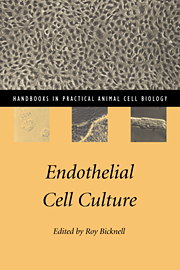Book contents
- Frontmatter
- Contents
- List of Contributors
- Preface to the series
- Acknowledgement
- 1 Introduction to the endothelial cell
- 2 Lung microvascular endothelial cells: defining in vitro models
- 3 Bone marrow endothelium
- 4 Endothelium of the brain
- 5 Isolation, culture and properties of microvessel endothelium from human breast adipose tissue
- 6 Human skin microvascular endothelial cells
- 7 Microvascular endothelium from adipose tissue
- 8 Endothelium of the female reproductive system
- 9 Synovial microvascular endothelial cell isolation and culture
- Index
8 - Endothelium of the female reproductive system
Published online by Cambridge University Press: 03 November 2009
- Frontmatter
- Contents
- List of Contributors
- Preface to the series
- Acknowledgement
- 1 Introduction to the endothelial cell
- 2 Lung microvascular endothelial cells: defining in vitro models
- 3 Bone marrow endothelium
- 4 Endothelium of the brain
- 5 Isolation, culture and properties of microvessel endothelium from human breast adipose tissue
- 6 Human skin microvascular endothelial cells
- 7 Microvascular endothelium from adipose tissue
- 8 Endothelium of the female reproductive system
- 9 Synovial microvascular endothelial cell isolation and culture
- Index
Summary
Introduction
The vasculature of the female reproductive tract is intimately involved in the processes of ovulation, menstruation, implantation, placentation and fetal development. These tissue beds have the unique property of undergoing benign angiogenesis, a process otherwise restricted to tissue repair. This chapter will describe the isolation and culture of the endothelium of the corpus luteum and of human first trimester (early pregnancy) decidua. It will also briefly cover the endothelium of other female reproductive tissues. No description will be given of the isolation and culture of human umbilical vein endothelium (HUVEC) since this has been described in Chapter 3.
The ovary
Mammalian ovarian follicles possess a well-developed capillary bed that delivers nutrients, growth factors and gonadotrophins required for the growth and maturation of the follicle and subsequent transformation into a corpus luteum. Ovarian follicles are thought to control the development of their own capillary bed, although there is no strong evidence to support this. Various regulators of angiogenesis have been identified in ovarian tissue, including epidermal growth factor (EGF), transforming growth factor α (TGFα), transforming growth factor β (TGFβ), basic fibroblast growth factor (bFGF), tumor necrosis factor α (TNFα), interleukin-1 (IL-1), inhibin and activin. The precise role played by each factor is not understood. Inhibition of ovarian angiogenesis could give rise to the development of new contraceptive agents.
During the menstrual and oestrous cycles, the ovarian follicle ruptures at ovulation and then develops into the corpus luteum which contains a well-developed microvasculature. Attempts have been made to isolate and culture endothelial cells from bovine and rabbit corpora lutea (Spanel-Borowski & Bosch, 1990; Bagavandoss & Wilks, 1991; Fenyves et al, 1993) and detailed methods are given in the following section.
- Type
- Chapter
- Information
- Endothelial Cell Culture , pp. 101 - 114Publisher: Cambridge University PressPrint publication year: 1996



